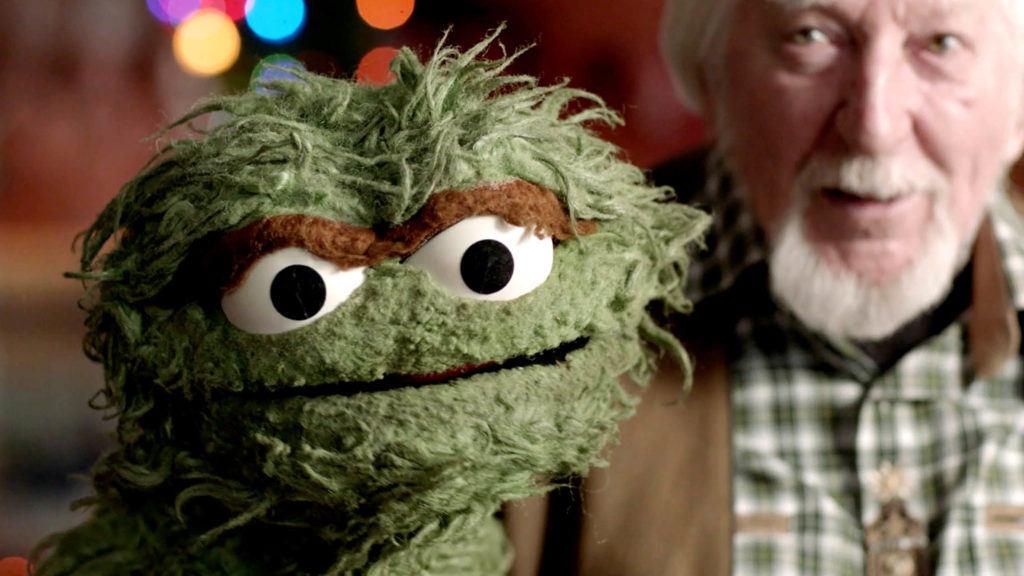Street Gang: How We Got To Sesame Street

Oscar The Grouch and Carroll Spinney in Marilyn Agrelo's STREET GANG: HOW WE GOT TO Sesame Street. Image courtesy Sundance Institute.
“The people who control the system read, and the people who make it in the system read.” – Joan Cooney
While Generation Z struggles to regain a footing in their public education after four years of Betsy DeVos driving the Department of Education into the ground, my generation grew up in one of the most information-enriched periods thanks to John Stone and the Children’s Televsion Workshop.
The series, now in its fifty-first year reaching 150 million people, began as the brainchild of John Stone and Joan Cooney, as a way to do “what television would do if it loved people instead of trying to sell to people.”
As Cooney put it, ““Every kid was singing [the themes] to beer commercials. Now where did they learn beer commercials? To me it was clear.” Children gravitated increasingly toward the medium of television, but CTV was the first organization which set about realizing its potential. In their feasibility study, they discovered that children spent about half their day watching television. The only other activity that came close to that level of engagement was sleep.
The documentary, directed by Marilyn Agrelo, explores how, inspired by ads for the Urban Coalition, Stone, Cooney, and Jim Henson teamed up to leverage the medium across 130 episodes with an $8 million budget to reach the many inner city children for whom TV served as a kind of surrogate while their parents worked longer and longer hours to make ends meet.
STREET GANG presents characters who need little introduction—Bob (Bob McGrath), Maria (Sonia Manzano), Gordon (Roscoe Orman/Matt Robinson)—as well as a few who we’re surprised to learn more about. We know the trashcan-squatting grouch named Oscar, but the documentary explains him as a manifestation of adult cynicism in contrast to the childlike mind of Big Bird—both characters created and performed by Carroll Spinney.
I started watching Sesame Street around 1976, four years after Matt Robinson left the role of Gordon. A local television personality hosting Philadelphia on WFIL’s Black Book, Robinson created a short-lived character, Roosevelt Franklin, with the intent of celebrating diversity rather than homogenizing it. Black audiences, however, were wary of playing to types they’d already seen on commercial TV. We people of color strive to have our success recognized in different ways. Some of us want recognition for our individual success. Others find it by assimilating into the broader society.
I’m astonished by how well Sesame Street took its concept of inner city vibrance and presented it in a fashion that taught you by sheer exposure, rather than heavy-handed messaging. While I’m Indian-American, Luis (Emilio Delgado) was likely the first person I saw on television who resembled my people. That exposure alone had to have just as profound an impact on the suburban, white kids as it did on me.
The series, like its cousin Mister Rogers Neighborhood, also tackled other challenging subjects including the death of a cast member. Anyone who was anywhere near Sesame Street in 1982 will recall Big Bird grappling with the loss of the shopkeeper, Mr. Hooper (Will Lee). Many show runners would have written the character off any number of ways, but Stone, Cooney and the cast reasoned their audience of three to five year olds deserved better from a series that always embraced, rather than condescended to, its audience. They found a perfect opportunity for discussion, as Big Bird and his friends learn to process grief.
While the documentary glosses over the impact of Jim Henson’s passing and the transition from public to premium television, what’s truly fascinating is how Sesame Street co-opted a commercial medium for progressive ends through simple gestures—Jesse Jackson leading kids in “I Am Somebody” or James Earl Jones, a stutterer, reciting the alphabet—keeping alive the subversive spirit of Henson’s dark comedy on Sam & Friends, an early precursor to The Muppet Show. On Street’s many achievements not the least of which was Kermit the Frog’s tender lament in “Bein’ Green,” songwriter Joe Raposo reflects, “To know we can become something that we perhaps never dreamed we could be, that’s what Sesame Street’s about.”